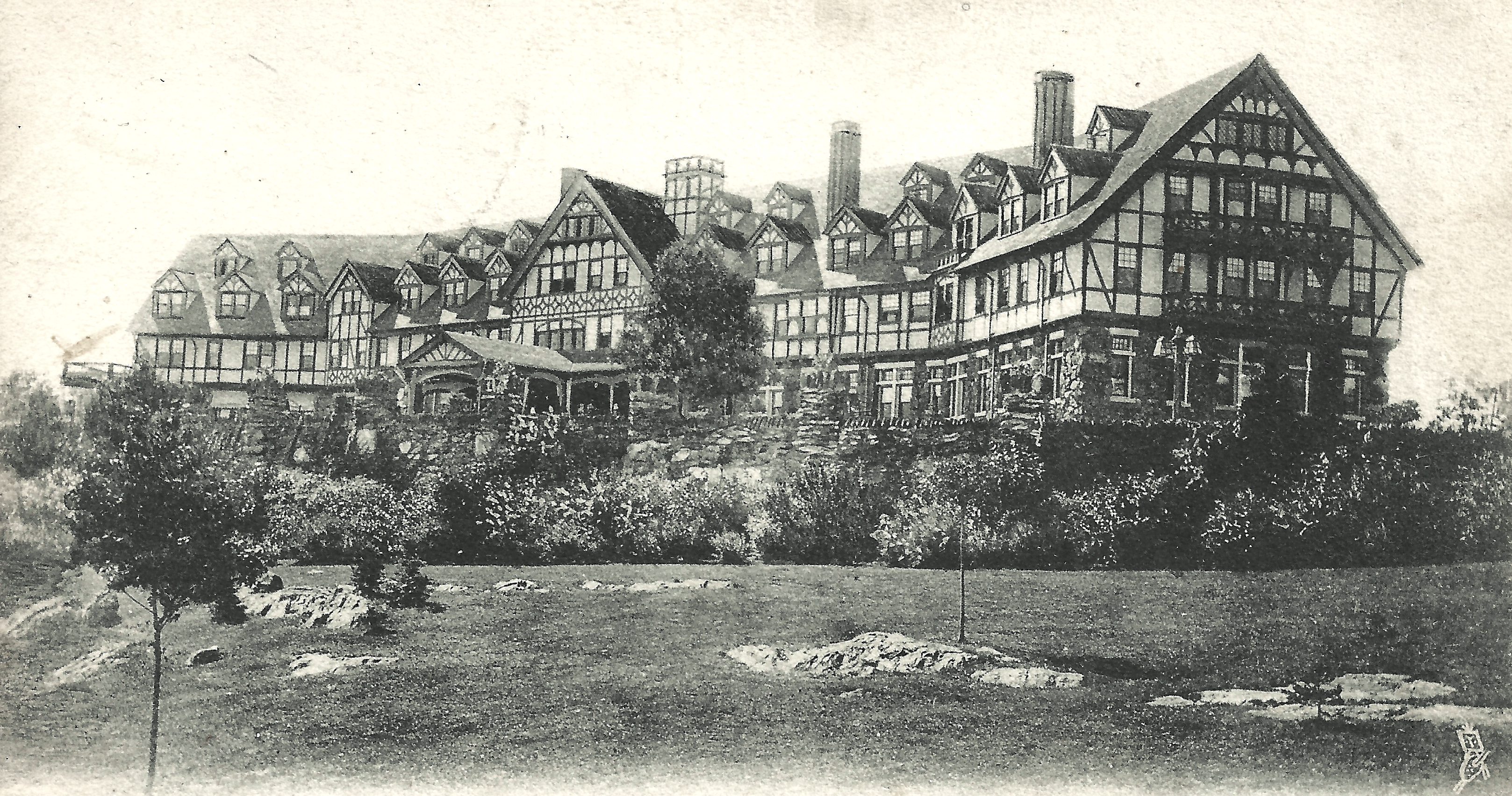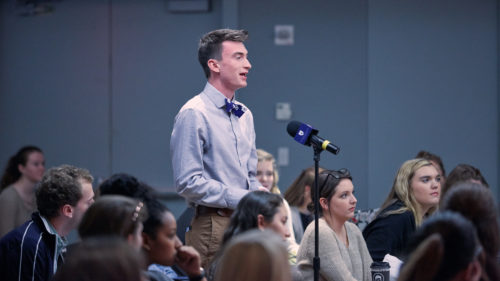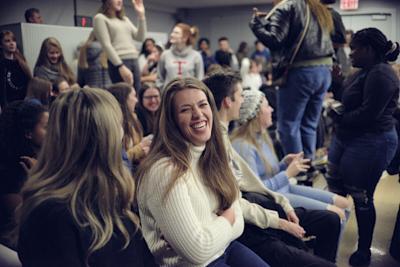November 2016 History Spotlight: The Swift Rise and Slow Fall of Briarcliff Lodge
When the Tidewater Associated Oil Company bought up the land around King’s in Delaware and persuaded the county to rezone it for industrial development, the College was forced to sell the Lexington mansion and estate where it had spent fourteen years of productive growth. The next step was the famed and beloved Briarcliff Manor.

When the Tidewater Associated Oil Company bought up the land around King’s in Delaware and persuaded the county to rezone it for industrial development, the College was forced to sell the Lexington mansion and estate where it had spent fourteen years of productive growth. The next step was the famed and beloved Briarcliff Manor.
The town of Briarcliff Manor came after the lodge was built. Walter William Law, an English-born businessman, bought what is described as a “small, worn-out and unprofitable farm” belonging to James Stillman in 1890. He was 53 years old at the time and had spent his career as a carpet salesman for the W&J Sloane Company, which represented several carpet factories in Yonkers. He was the firm’s first traveling salesman, becoming a partner after two years in 1866. He moved to Westchester for health and family reasons, retiring in 1899 from the carpet business. By that point he was already absorbed in building a “model farm”—he had already built his first guest lodging at the Dysart House on Pleasantville Road—and it became his second life’s-work. His efforts grew rapidly. The Stillman property was 232 acres; he would later accumulate 5,200.
“The design of the farm,” according to a historical volume on Briarcliff Lodge by local researcher Rob Yasinac, “was a serious, methodical system for manufacturing the best possible agricultural products for human consumption.”[1] Law’s early focus was dairy farming, and he emphasized clean procedures and gentleness with the cattle. The farm sold its milk at high-end hotels and restaurants in New York City and won a gold medal at the Paris Exposition in 1900.[2] Also in 1900, Law opened the School of Practical Agriculture, where “students were taught scientific basics of farming and gardening, as well as product conservation and the development of specialty markets for fine goods.”[3]
The first phase of Briarcliff Lodge was completed in 1902—just three years after Law’s formal retirement. Designed by architect Guy King, it was built in the Tudor style that was popular at that time, but it also resonated with Law’s English roots. “In [Briarcliff Lodge] was to be placed every convenience, and every device which modern luxury demands. Without it was to be a dream of architectural beauty; within, an illustration of the refined and artistic era in which we live.”[4] The original building was framed with timber, but the north and west wings added in 1907 and 1909, respectively, were of concrete and steel with fire safety in mind. It had about 75 guest rooms at the beginning and more than 220 after the additions, and parts of both the lodge and some of its accessory buildings were built to be serviceable for dirigible landings, as the expectation of that time was that these airships would be the next great travel innovation.
The village of Briarcliff Manor incorporated in 1902, the same year the lodge opened. Law owned nearly all of the land in the village and employed most of its 100 residents. He had provided them with employee housing, a new church, and a new railroad station; however, he did not govern the town. Law did not, ultimately, find the farmland in Briarcliff Manor all that workable, so he moved Briarcliff Farms to Dutchess County. The many buildings he had constructed near the lodge served to show off the area’s potential for residential development.[5]
The lodge’s reputation rapidly grew. In 1909, New York and New Jersey held the Hudson-Fulton celebration, honoring the three-hundredth anniversary of Henry Hudson’s first expedition up the Northeast’s greatest river, and the hundredth anniversary of Robert Fulton’s launching the Clermont. “Briarcliff Lodge was in top condition for the thousands of tourists who passed through its doors. By the end of the first decade of the century, Briarcliff Lodge had firmly established itself as the premier resort in the Hudson Valley, if not the country.”[6] Its patrons over time included members of the Rockefeller family, Thomas Edison, Elihu Root, Franklin Roosevelt, politician Al Smith, actress Tallulah Bankhead, Babe Ruth, John Campbell of the Campbell Apartment at Grand Central Terminal, and the King and Queen of Siam. It was a place where New York City elites would spend whole summers—but it also hosted a variety of community events over its lifespan.[7]
In 1923, the Law family leased Briarcliff Lodge to be managed for the next 20 years by Chauncey Depew Steele, a 30-year-old assistant manager at the Algonquin Hotel in New York City, whose father was prominent in Westchester county. Law died the following year, but he had made a good choice in Steele. Advertising under Steele compared Briarcliff Lodge to St. Moritz, a luxury alpine resort in Switzerland, and he brought the lodge to its height of fame. One of the main ways he did this was by tapping into the national passion for athletics and bodily health that was so strong at that time—especially in winter sports, which helped complement the lodge’s summer popularity. He expanded the resort’s athletic facilities and sports clubs, offered memberships to suburbanites, hosted high-achieving professional athletes and collegiate clubs, opened an 18-hole golf course designed by one of the nation’s foremost golf course architects, and held sporting exhibitions to entertain and draw residents of the area.[8]
However, the times they were a-changing. Henry Law, Walter’s son, believed Prohibition caused the decline in business that Briarcliff Lodge began to experience in 1930. Prohibition had been in effect since 1920 and was repealed in 1933, so he may or may not have been correct. Widespread use of automobiles did have an effect, however, as guests became less likely to stay at the lodge for the whole summer. Steele relinquished his lease in 1933 after half its duration, moving on to manage a hotel in Boston. The lodge stayed open year-round as a hotel for three more years, but was then rented to the Edgewood Park School, a junior college and preparatory school for women. The hotel only operated thereafter during the summers, while school was not in session, until 1939. Walter Law’s grandson Theodore Law, acting for the Briarcliff Lodge Association, sold the lodge plus 23 acres of land to the school in 1937, reportedly for $750,000[9]—now a not-uncommon sale price for a 2-bedroom apartment in Brooklyn.
Edgewood Park was a Christian school with 278 students enrolled in 1937. It was academically rigorous and offered training that would allow young women to make their own way in the world “if that be necessary.” Its degrees included arts, costume design, home economics, interior decoration, journalism, kindergarten, liberal arts, medical assisting, and secretarial science. Daughters of the school’s founder, and their husbands, served in a number of faculty and administrative roles. A message to the graduating class in its 1953 yearbook from one of the founder’s daughters reads, “Blessings on these young people…who are so soon to go out from us. I hope that they may be given to see that they will write the record of their years in human life; that the value of their living will be measured by the qualities they put into that living. I pray that they may from day to day add to their faith, courage; to courage, wisdom; to wisdom, patience; and to patience, Godliness, kindness and charity. May they give their best to life, and in giving, receive from life the best, so that their joy may be full.”[10] Despite its educational quality, it was never granted junior college accreditation.
Yasinsac writes, “In August 1954, Theodore Law, who held the mortgage on Briarcliff Lodge, foreclosed on the Edgewood Park School, which defaulted on interest payments by upward of 60 days. Edgewood Park came up with the money after being delivered notice, but a court ruling upheld Law’s right to foreclose. The school never reopened.”[11] After this, disputes arose in the village of Briarcliff Manor as to how the property should be used. Plans for a hotel were protested. A group of buyers entered into a purchase agreement with Law, but withdrew when the zoning process dragged on too long—even though a court ruled in their favor, based on the lodge’s original use and profitability. So it sat empty for a year, until The King’s College purchased it in the summer of 1955 for $380,000.[12] It was just over half the price Edgewood Park had paid.
Despite the unfortunate situation in Delaware, King’s students met the impending move to Briarcliff Manor with great excitement. A two-page spread at the end of the 1955 Crown expresses the students’ eagerness to take up residence in the Hotel Beautiful of years past. Even today, the Briarcliff Manor years are widely regarded among many alumni as the College’s heyday.
Enrollment was at 300 in 1955—its highest to date at that point—and grew to 870 in the 1979-1980 academic year. The College also set immediately to work expanding its physical plant—it bought nearby Braeview as the president’s home (Percy and Ruth Crawford moved their family there in the spring of 1956, when Percy realized the College needed its leader to have a stronger presence on campus than his prior once-a-week visits[13]) and off-campus faculty housing, built Squire Hall as the new gymnasium, and updated the electric and heating systems in Briarcliff Lodge. After Dr. Robert A. Cook became president in 1962, the College expanded its library, built a new dormitory (Miller Circle) and the Cook science building, and bought additional properties for residential use and additional facilities, including the Tarry Hill Swim and Tennis Club, which later hosted the popular Royal Rock day camp, and Walter Law’s original mansion, which was dubbed “the Castle” and served as a men’s dorm. Who can fail to acknowledge the intoxicating effect of living and studying (and perhaps falling in love) in such a place, still furnished with the riches and redolent with the memories of New York’s dignitaries and millionaires, or the glowing warmth and spiritual fatherliness of Dr. Cook himself?
As early as the days when Percy was thinking about buying the property, it was evident that “every modern convenience” from the lodge’s turn-of-the-century construction was no longer up to date—particularly where the wiring was concerned. Maintenance at the College over the years was reportedly of a hasty variety, or done by visiting church groups as a service.[14] The much lower purchase price that King’s paid compared to Edgewood Park has already been noted; even considering Percy’s formidable negotiating skills, it is worth adding that the group wanting to redevelop the property as a hotel after the Edgewood Park foreclosure had been prepared to spend $500,000 on improvements. Even that might not have been enough. The sale price of the Delaware campus was $1.25 million, and Dan Crawford writes, “It very soon became apparent [after the move] that the reserve funds from the sale of the Delaware campus would have to be used for the development and maintenance of the new property and that the college would need to find new sources of revenue”[15] (emphasis added). Dan Crawford’s book and alumni interviews conducted during the present history project do not show that either Percy Crawford or Bob Cook engaged in extensive fundraising beyond their radio constituencies. These difficulties were later compounded by outside forces. Yasinsac’s book tells the story concisely:
“Deferred maintenance on the aging buildings had been noted [during the Cook years], and the village board also opposed expansion plans in the 1970s, making the school less attractive to prospective students. Zoning laws limited what could be built and where, as new buildings could not be erected near adjacent properties. In 1985, after Cook retired, Friedhelm K. Radandt was brought in to stabilize the school.
“Radandt tried to upgrade the Briarcliff campus, but it soon became apparent that a move was necessary in order for The King’s College to survive…In 1991, the college purchased 168 acres in Orange County, New York, from Blue Lake Properties for $12 million. The school took title to the new campus despite paying down a minimal amount. However, the delayed sale of the Briarcliff property to finance the new purchase…nearly destroyed The King’s College. As enrollment bottomed out and teachers (unsure of their future) left, the state education department stripped the school of its accreditation and ordered it to close on December 31, 1994.
“After the Briarcliff campus closed, the school sought to sell the property and use the funds to erase debt and open the new campus. In what was described by a federal judge as a ‘miracle,’ the college successfully staved off a mortgage foreclosure attempt by Lehman Brothers, holders of the mortgage on the Briarcliff campus. Radandt raised $5 million in 1997 to pay off debt, and the school survived by trading the Briarcliff campus to Blue Lake Properties for the Orange County site.”
There is, of course, more to that story, which we hope to tell in due course. But what about the campus? It was to be sold to Tara Circle, a nonprofit Irish cultural organization, for $14 million. They planned to build “the largest cultural center outside of Dublin,” with a genealogy and research library, a museum for Irish artists, a banquet hall, dining hall, and lounge, and facilities for athletic competitions. But again, the village objected. Residents cited fears of traffic, noise, and congestion, organized an association, and filed a lawsuit to dismiss Tara Circle’s temporary special-use zoning permit, which had been granted in advance of the actual sale. Tara Circle filed a counter-lawsuit claiming anti-Irish bias, which was rejected in Manhattan’s Federal Appeals Court. Yasinsac writes, “The issue deeply divided the residents of Briarcliff Manor, and the words of some residents at village meetings inspired letters of protest from across the country in favor of Tara Circle.”[16]
As Tara Circle began looking for a new site, King’s completed its trade with Blue Lake Properties in December 1997. Blue Lake Properties sold it to a developer from Illinois called Barrington Venture in 1998, which planned to raze all of the campus buildings and build a retirement community there. As these plans were debated and contested—a local architect and volunteer fireman estimated the lodge could be saved for about 4% more than the cost of a total do-over—the lodge sat vacant and unguarded. Some vandalism occurred, and the campus sank into deep disrepair. Barrington Venture’s development plan was approved in the spring of 2003, and they planned to start demolition that fall,[17] but fire got there first. The original wood timber section of the lodge caught fire for unknown reasons early in the morning of September 20, 2003. The west and north wings, made of steel and concrete, served their purpose and did not collapse—but their abundant wood paneling burned. A few items were salvaged and sold at antique shops in New York City for princely prices.
Today, it appears that the plans to build a retirement community are still in place. In the fall of 2015, a group of students in the House of Clara Barton visited the site—an old road sign still says “The King’s College”—and saw a developer’s sign with an illustrated site plan: “expected completion 2013.” The retirement community has a website that is fully functional, but communications have apparently not been maintained since 2014, and the famous hilltop remains bare.
What is the appropriate response to such a story? Many feel grief, heartbreak, anger, and loss—others thankfulness for what they experienced and relief that the college did not die—others, all of the above—others who weren’t there, a simple interest in knowing the facts. We serve a King who is wise and great enough to take up all of our responses, working in them and through them, even sometimes in spite of them, to build up the glory of His name. We at King’s are certainly thankful He chose to preserve the College through some of its darkest years and guide it to ever-firmer footing. May all members of our community be moved to respond to His providence and care with our greatest gratitude and effort for His kingdom.
Did we miss something? All questions, comments, memories, and notes about additional facts or resources should be directed to The King’s College Historian, Emily Schatz.
[1] Yasinsac, Rob. Briarcliff Lodge. “Images of America” series. Charleston: Arcadia. Pp. 9-10.
[2] Yasinsac, p. 23
[3] Yasinsac, p. 10
[4] Yasinsac, p. 19
[5] Yasinsac, p. 19
[6] Yasinsac, p. 20
[7] Yasinsac, p. 28
[8] Yasinsac, p. 41
[9] Yasinsac, p. 61
[10] The Sketchbook, yearbook of Edgewood Park, 1953, p. 5. Property of The King’s College library.
[11] Yasinsac, p. 61
[12] Yasinsac, p. 71
[13] Crawford, Dan. A Thirst for Souls: The Life of Evangelist Percy B. Crawford (1902-1960). Selinsgrove: Susquehanna University Press, 2010. P. 272.
[14] Yasinsac, Rob. “Briarcliff Lodge and The King’s College.” http://www.hudsonvalleyruins.org/yasinsac/kingscollege/kingscollege.html Accessed November 10, 2016.
[15] Crawford, A Thirst for Souls, p. 271-2.
[16] Yasinsac, p. 93





